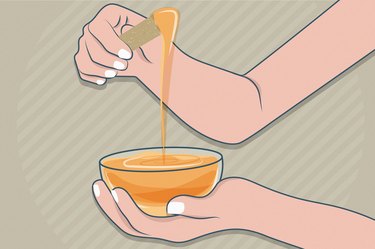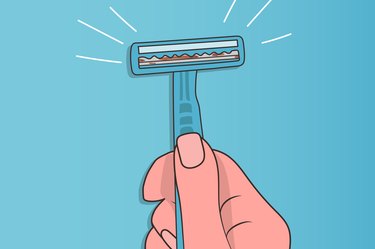
You're in the shower, you look down at your chest and — wait, what's that? Is it a hair? Why the heck is it coming from your nipple? Should you just pull it out?
Or maybe you're someone who's always had a few (or many) hairs in this sensitive area and are wondering if you can just take a quick swipe with the razor to get rid of it.
Video of the Day
Video of the Day
You've come to the right place. Whether it's an occasional, single nipple hair issue or things are a bit more textured, learn here whether nipple hair is normal, the risks of shaving it, other ways to remove this hair and important health considerations.
First, Is Nipple Hair Normal?
The answer is a resounding yes.
"The areola is a hair-bearing area," Heidi Prather, MD, a board-certified dermatologist with Westlake Dermatology in Austin (@heidiprathermd), tells LIVESTRONG.com. "Most people will notice some amount of hair around the areola, which is the darker part of the breast," she says.
This goes for both people assigned female at birth (AFAB) and those assigned male at birth, she adds.
Hair on your nipples or chest usually comes down to genetics, per Nemours Children's Health. It can also show up when your hormones are fluctuating, like during pregnancy or menopause, per Cedars Sinai.
But in people AFAB, excess hair growth can sometimes be a sign of a hormone problem like polycystic ovary syndrome, per Johns Hopkins Medicine. If you have nipple hair along with symptoms like irregular or missed periods, weight gain, skin tags or dark, thick patches of skin in the armpits, under the breasts or on the back of the neck, see a doctor to get checked out.
3 Risks of Shaving Your Nipple Hair
The good news is that when you're looking for how to get rid of nipple hair, shaving is a perfectly acceptable way to do it.
And while the areola is naturally a more sensitive area that requires a gentle touch, "today's razors are made so well to minimize risks of knicks and cuts," Dr. Prather says. "If you can see the area well, you can safely shave it. But do what you're most comfortable with," she adds.
So, risks are pretty minimal, but they might include:
1. Skin Irritation
Like other methods of hair removal, shaving comes with the risk of skin irritation. This could include razor bumps and burn, which of course can happen anywhere you shave. You can reduce your risk of these conditions by moistening the area with warm water or shaving gel, choosing a sharp razor, using short strokes while shaving in the direction of hair growth and applying moisturizer to the area afterward.
2. Ingrown Hairs
When regrowing, hair can get trapped under the skin, causing an ingrown hair. These will look like red, acne-like bumps. Prevention tactics here include shaving in the direction of hair growth, gently exfoliating the area and shaving toward the end of a shower, to give the steam time to open up your pores.
3. 'Thicker' Nipple Hair
When you shave, the razor cuts the hair bluntly, and so it can be perceived as thicker when it grows back. "Instead of a fine taper, you'll have a rough hair that was cut at the root," Dr. Prather explains. This won't bother everyone. But if it's not the look or texture you're going for, you may want to consider other options for removing nipple hair.
How to Safely Get Rid of Nipple Hair
Here are some safe options for removing nipple hair, Dr. Prather says:
- Electrolysis: A fine needle is inserted into a hair follicle to destroy the hair's ability to grow. This can be used on all skin tones and hair colors and types, per the American Electrology Association.
- Laser hair removal: Uses light to damage the hair follicle, to stymie hair growth. Darker hair is needed for laser hair removal to work.
- Plucking with tweezers: Great for the occasional, one-off hair.
- Shaving: Easy to do, not painful and cheap.
Electrolysis is the best option to get rid of nipple hair permanently. As the American Electrology Association points out, the treatment is ideal for areola hair. (The association says it's relatively comfortable, but each person's experience may be a bit different. The Cleveland Clinic recommends talking to your provider about a numbing cream if you're uncomfortable.)
Laser hair removal is not permanent, but fewer hairs grow back, and when they do, they're finer in texture, according to the American Society of Plastic Surgeons.
Keep in mind, though, that both electrolysis and laser hair removal can be expensive and time-consuming (you typically have to sit through several sessions).
When looking for a reputable place that can remove nipple hair with your safety in mind, Dr. Prather recommends going to a board-certified dermatologist. If you're going to a center, make sure a board-certified dermatologist is overseeing the treatments. (You want to avoid burns and injuries to the skin.)
When to See a Doctor
"My biggest concern is always medical health. First and foremost, make sure that everything is healthy before pursuing aesthetic hair removal," Dr. Prather says.
There are some changes to breast skin and the areola that may be concerning and shouldn't be overlooked. Make an appointment with a board-certified dermatologist, an ob-gyn or your primary care provider to get checked out if you experience:
- Unintentional hair loss
- Skin rashes that don't go away
- Non-painful, non-itchy, pink to red skin that develops slowly (may look like acne or eczema but doesn't go away)
- Red bumps similar to an ingrown hair
These can all be indicative of changes that occur with skin cancer. (Because, yes, you can have skin cancer on any part of your body.)
In addition, nipple changes can also occur with breast cancer, including Paget disease, a rare type of the cancer where the nipple and areola look eczema-like with crusted, red scales, per the American Cancer Society.
So, How Bad Is It Really to Shave Your Nipple Hair?
If you have hair around your nipples, you can be assured your body is normal, and your neighbors, friends and parents probably have hair around their nipples, too.
Which is to say: There's nothing wrong with you if you have nipple hair, and you don't have to remove it.
But if you are looking for how to get rid of hair on your breast, shaving, plucking, laser hair removal and electrolysis are all good options, depending on your skin and hair type, as well as your goal and budget.
- American Electrology Association: "What is Electrolysis?"
- American Electrology Association: "Electrolysis for breasts and sensitive areas"
- American Society of Plastic Surgeons: "Laser Hair Removal"
- American Cancer Society: "Paget Disease of the Breast"
- Cleveland Clinic: "Electrolysis"
- Nemours Children's Health: "How Do I Remove Hair Around My Nipples? (for Teens)"
- Johns Hopkins Medicine: "Polycystic Ovary Syndrome (PCOS)"
- Cedars Sinai: "Hirsutism in Women: Excess Body Hair Growth"
Is this an emergency? If you are experiencing serious medical symptoms, please see the National Library of Medicine’s list of signs you need emergency medical attention or call 911.



